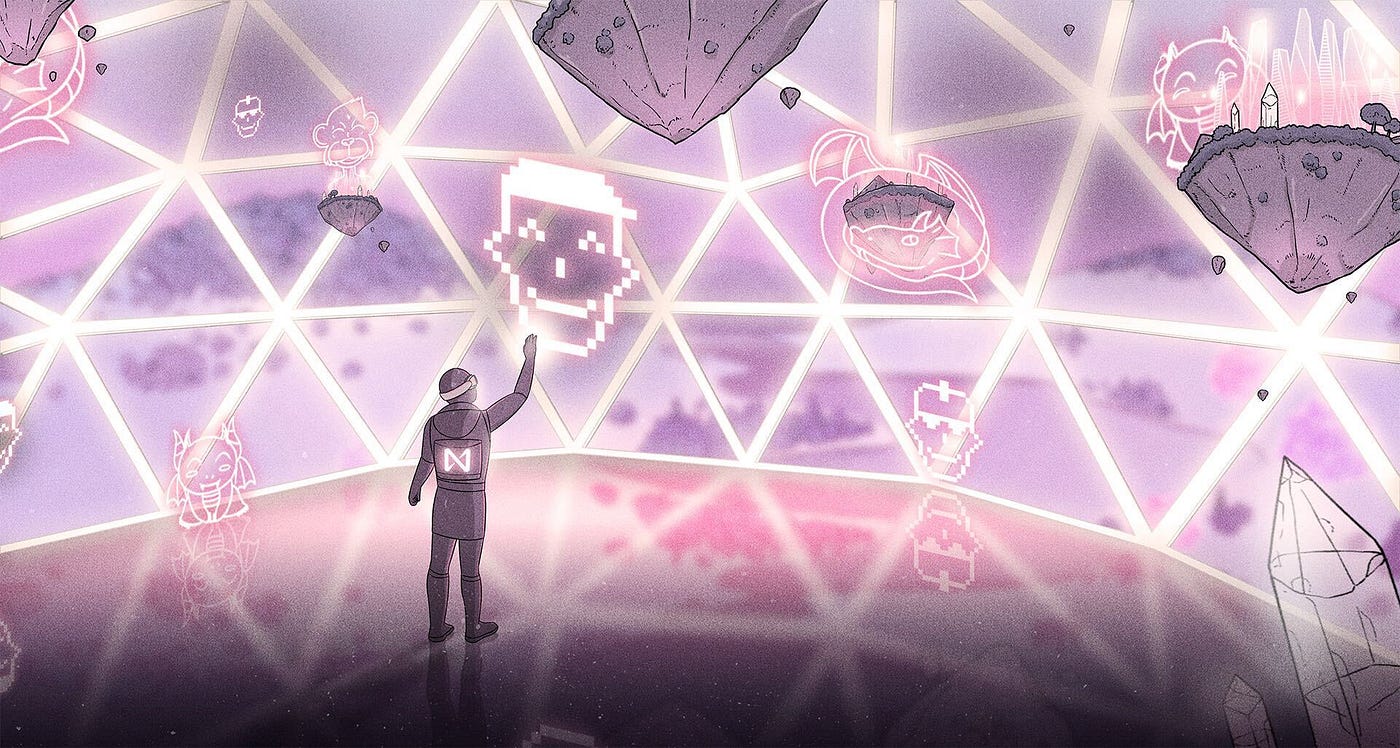If you think about the current developments in video games and in the Metaverse, we come closer and closer to a realistic replica of our reality. Do we want that?
Simple graphics for blockchain games
Blockchain and gaming are finding more and more points of contact. A good example of this is Solana Ventures, the investment division of Solana Labs, which plans to set up a $ 150 million fund for blockchain gaming. The fund is intended to invest in gaming startups that are based on the Solana blockchain.
According to The Block Crypto , blockchain gaming and NFT startups raised a record $ 1 billion in November. Since gaming on the blockchain is still in the development phase, impressive graphics don't seem to be a priority at the moment. Popular blockchain games like Axie Infinity are kept very simple for 2021. The blockchain gaming platform The Sandbox is also more reminiscent of the simple graphic style of games like Minecraft .
Illuvium , for example, shows that there is another way . The Ethereum- based AAA blockchain game relies not only on innovative technology but also on high-quality graphics. This could be seen in the impressive Gameplay Reveal trailer . However, if you compare the graphics of the blockchain game with the advances in the field of graphics engines for gamers, it looks rather dated.
Realistic graphics with the Unreal Engine 5
We have been moving in the Uncanny Valley for a long time . This is the term used to describe the period in which people's imitation still feels strange and inauthentic and we are, so to speak, in an “uncanny valley”. But these times seem to be nearing their end when you look at the almost realistic graphics of the latest Unreal 5 engine .
In a current tech demo of the engine, Matrix lead actor Keanu Reeves actually looks “breathtaking”, comments a user on YouTube and alludes to the popular meme . The scenes shown are intended to clarify the possibilities of the engine and often look like real, playable film scenes.
Better accessibility through cloud gaming
With innovations such as cloud gaming, users no longer need power computers, but can easily play complex games even with the highest settings, even with normal devices.
Because the computing power of cloud gaming services like Stadia is outsourced and streamed from Google's data centers to the users' devices, similar to streaming services like Netflix . And all of this without the need for huge downloads. This makes playing graphically complex games directly accessible even to average gamers.
Human interaction in the metaverse
The human interaction via facial expressions and body movements is almost completely absent in the world of the Internet until now. But with the metaverse, VR technologies and hyper-realistic graphics, the ability to communicate more expressions is becoming more and more realistic.
Andrew “Boz” Bosworth , Vice-President at Facebook, is working on the Meta's Interaction SDK , according to the Meta introduction video . The technology makes it possible to link hand gestures in virtual reality with apps.
"Realistic presence is key to feeling connected in the Metaverse."
In retrospect, we may wonder how we endured such a boring internet for so long. Because when, from a certain point in time, the almost realistic graphics, as in the Unreal Engine 5, merge with VR experiences and the metaverse , we come closer and closer to an almost complete replica of our reality.
And where is that going?
With all the hype and fascination with the technology, we should ask ourselves briefly where all this is going. After all, we are in the process of creating an increasingly accurate, digital replica of the real world. This could soon compete with our physical world. Does this actually enrich it or does it even move into the background? And shouldn't human interactions take place in the physical world rather than in a digital imitation of it?
Roger McNamee, one of the early Facebook investors, also thinks that we should think carefully about who to leave the development of a metaverse to. He described Meta's plans for the Metaverse as "dystopian" to the BBC .
“That's a bad idea, and the fact that we all sit and take it for granted should terrify everyone. (...) We must not allow Facebook to build a dystopian metaverse. "
However, the investor does not generally see the idea of the metaverse as wrong. He only sees responsibility in the wrong hands with Mark Zuckerberg. He adds that “no regulation should allow Facebook to operate in the Metaverse or enter crypto currencies”.
My Top PicksHoneygain - Passive earner that pays in BTC or PayPalMandalaExchange -The Best no KYC crypto Exchange!
BetFury - Play And Earn BFG for daily Bitcoin and ETH dividends!
Pipeflare - Faucet that pays in ZCash and Matic, Games pay in DAIWomplay - Mobile dApp gaming platform that rewards in EOS and BitcoinCointiply - The #1 Crypto Earning SiteLiteCoinPay -The #1 FaucetPay earner for LitecoinUpland - Collect Digital Properties & Test Your SkillsLBRY/Odysee - YouTube Alternative that lets you earn Money by viewing videos!FaucetPay - The #1 Microwallet PlatformFREEBTC - The #1 FaucetPay earner for Satoshi'sFaucetCrypto - An earning/faucet site that pays out instantlyFireFaucet - An earning site that pays better for some than Cointiply
DogeFaucet - Dogecoin Faucet
xFaucet - BTC, ETH, LTC, Doge, Dash, Tron, DGB, BCH, BNB, ZEC, FEY - Claim every 5 minutes
Konstantinova - BTC, ETH, LTC, Doge, Dash, Tron, DGB, BCH, BNB, ZEC, USDT, FEY, 25 Claims Daily
Disclaimer of liability
All information contained on our website has been researched to the best of our knowledge and belief. The journalistic contributions are for general informational purposes only. Any action that the reader takes based on the information found on our website is entirely at your own risk.


Comments
Post a Comment